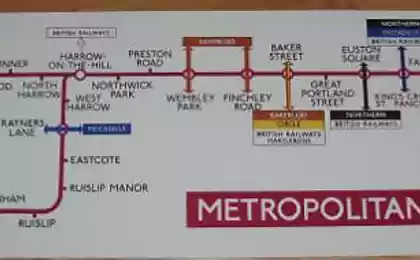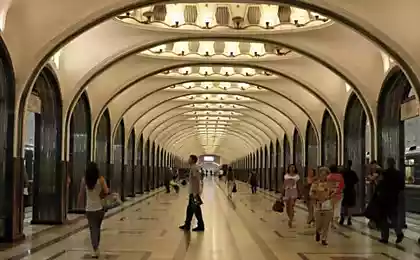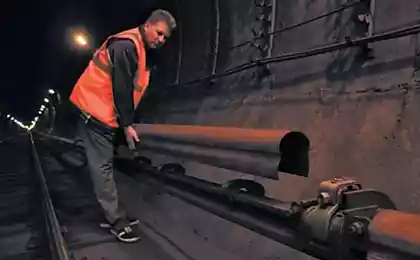1339
All-seeing eye of the Moscow metro
Moscow subway - is a zone of high risk.
To ensure proper safety of the passengers, a large number of employees, we have real-time to receive a huge amount of information quickly to analyze it and make decisions in case of emergency situations.
I propose to learn how to live takes this complex process.
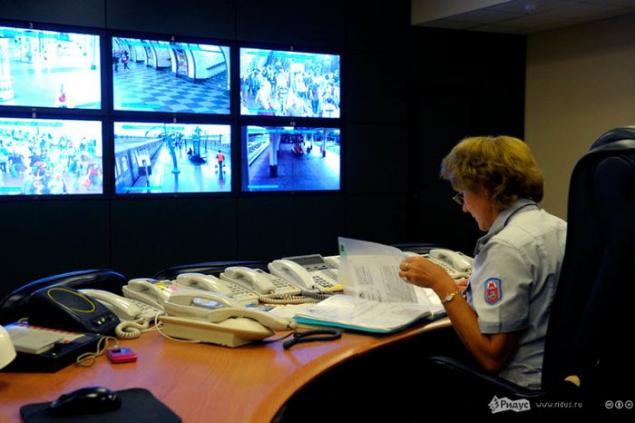
Author: I go into the large room in the center - a large round table on duty on the subway, like a bridge. Left - operator workstations with two or three monitors to each, and in the center - immediately attracting the attention of a wall of screens that - lobbies, escalators, cars. The situation in the center is very business-like, if not - tense: no one does not sleep with a mug of tea in the office - every time we hear calls scraps negotiations on handsfree conversations operators with passengers.

As I said Konstantin Pakhomov, chief engineer of the Situation Centre of the Moscow Metro, flocked here audio and video from all stations of the Moscow metro. Broken down train, escalator does not work, disrupted some devices that detected suspicious items was smoke - everything becomes known in a matter of minutes.
Duty on the subway first checks the data and then forwards the information to the appropriate underground services. Any cases related to malfunctions, even trifling, reported to the head of the underground - via SMS or telephone.

Another objective of the Center - the interaction with municipal services. Direct link - the operational duty of all municipal services - heating network, power, gas networks, communications, water supply, public transport. For example, on one of the lines for technical reasons to close the station - should immediately contact Mosgortrans to have been allocated an additional bus to transport passengers.
On communication and emergency services - Ministry of Emergency Situations, ambulance, military commandant's office, FSB, police said. And it is a direct channel switches minuyuschy city telephone network - even in the event of a serious accident will have the opportunity to contact the "siloviki", rescuers and medics. There is a "hot line" and to communicate with the mayor of Moscow - the mayor should be aware of all the problems in the Moscow subway.

- When I started work Situation Centre, which gave rise to its creation? - I ask the Konstantin.
- In 2005. Three years later, we have improved on the basis of its accumulated experience and now the center works in the current configuration. There are two reasons. The first - before services were connected with the city traffic controllers every subway line separately. It was too long circuit reports the authorities and services of interaction subway. We realized that we should take these functions at the train dispatchers and concentrate them in one place. The second reason - the attacks. In 2005 it came into effect a comprehensive program to counter terrorism in the framework of which was created by the Situation Centre and the subway was equipped with special technical means - their own system of direct communication and video monitoring systems.
Together with the duty of the subway Lyudmila Pea come to the workbench. The monitor - electronic map of the stations Sokolniki line that marked the place of installation of video cameras. Lyudmila said that they in Moscow metro more than five thousand, and they control 95% of the passenger area. The operator, switching between cameras, watches everything that happens at the stations. Increased place at the box office - from the Center give to open new windows. Or, for example, the monitor shows that the people are crowding and somewhere to look - it means that something has happened. Special attention is, of course - abandoned objects.

The same operator receives calls from an emergency call columns, which are at each station. Just at that moment the bell rings - a man wants to know how to get him in Mytishchi near Moscow. It would seem that the question outside the competence of the employees of the subway, but the operator immediately replies: "You need to go to the station" Komsomolskaya "and take the commuter train." "Our operators - is very broad-minded - proudly says Lyudmila - and if the operator can not itself give passengers the right information, it is switched to the help desk subway».
At another workplace is monitoring cameras mounted in the cars. On the monitor, the operator - circuit line, which shows the position of the composition in a given time. In addition to cameras, if necessary, you can also connect to the negotiation of communication "passenger-driver." If the error was reported - he responds driver. If the crime - the operators CC associated with the duty on the part of the ATS underground, according to car number, routing number, to which he is removing from the nearest station, and the police take the necessary measures.
According to chief engineer SP, CCTV on trains operating on the ring, and Sokolniki Zamoskvoretskaya lines. And the cameras are installed not only in cars, but also in the cab and in the head of the convoy - usually recording their use in the investigation of accidents.
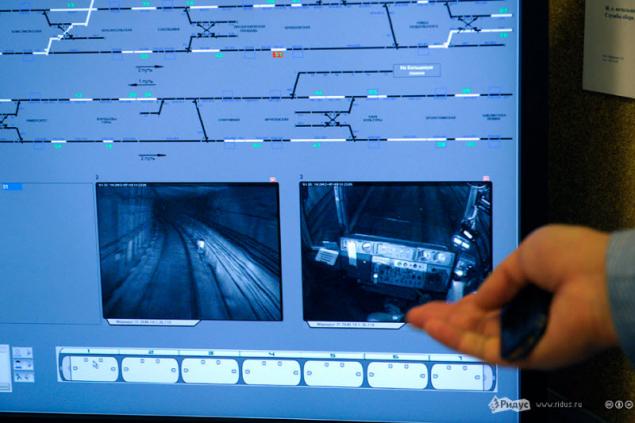
Changing operator - 12 hours. The work is not easy, requiring the utmost attention and concentration. And nervous, too - if the passenger "on emotions", it is often difficult to understand exactly what happened. Within seconds, the operator must soberly assess the information and make a decision - to which services address.
The image from any camera can be displayed on large monitors. I was able to personally observe how the staff of the Centre to respond to emergency we see on the screen that "Tepliy" all the passengers from the planted.

- The driver detected a fault ARS - cruise control system, which ensures safety, replacing traffic lights, - says Lyudmila. - A composition APC obtains information as the front space and the system issues a speed at which it can safely follow. This increases throughput - the trains run frequently. Composition with "Petrovsko-Razumovskaya" is now sent to the depot, where the train has already left the reserve, so as not to disturb the interval. We always try to deliver the least possible inconvenience to passengers.
So now, happily marching on the station or curled up on the seat in the car, you know - for you invisibly monitor the employees of the Situation Centre of the Moscow subway. Happened - they are prompt, help, save.
Thanks to the press service of the State Unitary Enterprise "Moscow Metro" for the help in the organization of reportage.
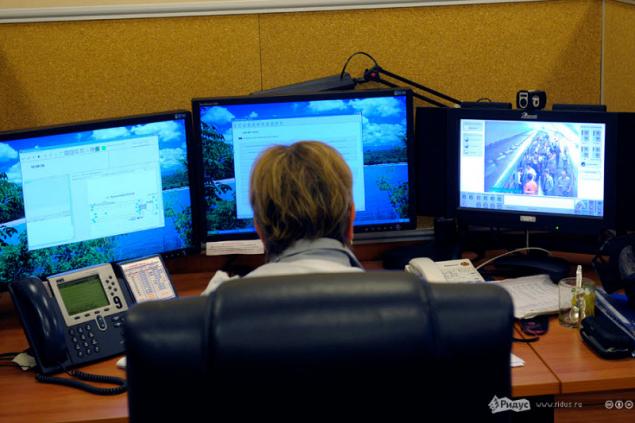
Source: www.ridus.ru
To ensure proper safety of the passengers, a large number of employees, we have real-time to receive a huge amount of information quickly to analyze it and make decisions in case of emergency situations.
I propose to learn how to live takes this complex process.

Author: I go into the large room in the center - a large round table on duty on the subway, like a bridge. Left - operator workstations with two or three monitors to each, and in the center - immediately attracting the attention of a wall of screens that - lobbies, escalators, cars. The situation in the center is very business-like, if not - tense: no one does not sleep with a mug of tea in the office - every time we hear calls scraps negotiations on handsfree conversations operators with passengers.

As I said Konstantin Pakhomov, chief engineer of the Situation Centre of the Moscow Metro, flocked here audio and video from all stations of the Moscow metro. Broken down train, escalator does not work, disrupted some devices that detected suspicious items was smoke - everything becomes known in a matter of minutes.
Duty on the subway first checks the data and then forwards the information to the appropriate underground services. Any cases related to malfunctions, even trifling, reported to the head of the underground - via SMS or telephone.

Another objective of the Center - the interaction with municipal services. Direct link - the operational duty of all municipal services - heating network, power, gas networks, communications, water supply, public transport. For example, on one of the lines for technical reasons to close the station - should immediately contact Mosgortrans to have been allocated an additional bus to transport passengers.
On communication and emergency services - Ministry of Emergency Situations, ambulance, military commandant's office, FSB, police said. And it is a direct channel switches minuyuschy city telephone network - even in the event of a serious accident will have the opportunity to contact the "siloviki", rescuers and medics. There is a "hot line" and to communicate with the mayor of Moscow - the mayor should be aware of all the problems in the Moscow subway.

- When I started work Situation Centre, which gave rise to its creation? - I ask the Konstantin.
- In 2005. Three years later, we have improved on the basis of its accumulated experience and now the center works in the current configuration. There are two reasons. The first - before services were connected with the city traffic controllers every subway line separately. It was too long circuit reports the authorities and services of interaction subway. We realized that we should take these functions at the train dispatchers and concentrate them in one place. The second reason - the attacks. In 2005 it came into effect a comprehensive program to counter terrorism in the framework of which was created by the Situation Centre and the subway was equipped with special technical means - their own system of direct communication and video monitoring systems.
Together with the duty of the subway Lyudmila Pea come to the workbench. The monitor - electronic map of the stations Sokolniki line that marked the place of installation of video cameras. Lyudmila said that they in Moscow metro more than five thousand, and they control 95% of the passenger area. The operator, switching between cameras, watches everything that happens at the stations. Increased place at the box office - from the Center give to open new windows. Or, for example, the monitor shows that the people are crowding and somewhere to look - it means that something has happened. Special attention is, of course - abandoned objects.

The same operator receives calls from an emergency call columns, which are at each station. Just at that moment the bell rings - a man wants to know how to get him in Mytishchi near Moscow. It would seem that the question outside the competence of the employees of the subway, but the operator immediately replies: "You need to go to the station" Komsomolskaya "and take the commuter train." "Our operators - is very broad-minded - proudly says Lyudmila - and if the operator can not itself give passengers the right information, it is switched to the help desk subway».
At another workplace is monitoring cameras mounted in the cars. On the monitor, the operator - circuit line, which shows the position of the composition in a given time. In addition to cameras, if necessary, you can also connect to the negotiation of communication "passenger-driver." If the error was reported - he responds driver. If the crime - the operators CC associated with the duty on the part of the ATS underground, according to car number, routing number, to which he is removing from the nearest station, and the police take the necessary measures.
According to chief engineer SP, CCTV on trains operating on the ring, and Sokolniki Zamoskvoretskaya lines. And the cameras are installed not only in cars, but also in the cab and in the head of the convoy - usually recording their use in the investigation of accidents.

Changing operator - 12 hours. The work is not easy, requiring the utmost attention and concentration. And nervous, too - if the passenger "on emotions", it is often difficult to understand exactly what happened. Within seconds, the operator must soberly assess the information and make a decision - to which services address.
The image from any camera can be displayed on large monitors. I was able to personally observe how the staff of the Centre to respond to emergency we see on the screen that "Tepliy" all the passengers from the planted.

- The driver detected a fault ARS - cruise control system, which ensures safety, replacing traffic lights, - says Lyudmila. - A composition APC obtains information as the front space and the system issues a speed at which it can safely follow. This increases throughput - the trains run frequently. Composition with "Petrovsko-Razumovskaya" is now sent to the depot, where the train has already left the reserve, so as not to disturb the interval. We always try to deliver the least possible inconvenience to passengers.
So now, happily marching on the station or curled up on the seat in the car, you know - for you invisibly monitor the employees of the Situation Centre of the Moscow subway. Happened - they are prompt, help, save.
Thanks to the press service of the State Unitary Enterprise "Moscow Metro" for the help in the organization of reportage.

Source: www.ridus.ru








